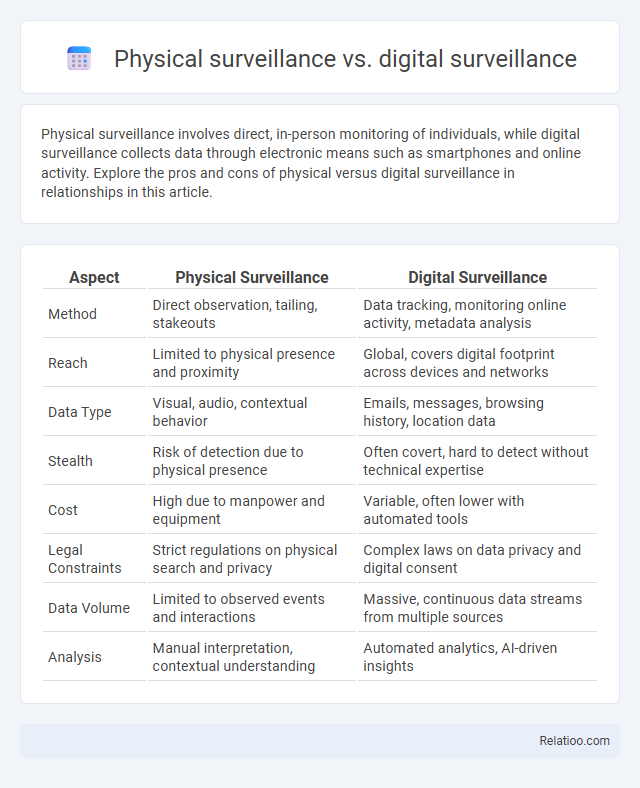Physical surveillance involves direct, in-person monitoring of individuals, while digital surveillance collects data through electronic means such as smartphones and online activity. Explore the pros and cons of physical versus digital surveillance in relationships in this article.
Table of Comparison
| Aspect | Physical Surveillance | Digital Surveillance |
|---|---|---|
| Method | Direct observation, tailing, stakeouts | Data tracking, monitoring online activity, metadata analysis |
| Reach | Limited to physical presence and proximity | Global, covers digital footprint across devices and networks |
| Data Type | Visual, audio, contextual behavior | Emails, messages, browsing history, location data |
| Stealth | Risk of detection due to physical presence | Often covert, hard to detect without technical expertise |
| Cost | High due to manpower and equipment | Variable, often lower with automated tools |
| Legal Constraints | Strict regulations on physical search and privacy | Complex laws on data privacy and digital consent |
| Data Volume | Limited to observed events and interactions | Massive, continuous data streams from multiple sources |
| Analysis | Manual interpretation, contextual understanding | Automated analytics, AI-driven insights |
Introduction to Physical and Digital Surveillance
Physical surveillance involves direct observation of a person or location using techniques like stakeouts and tailing, often relying on human presence and equipment such as binoculars or cameras. Digital surveillance leverages technology to monitor online activities, communications, and electronic data through tools like spyware, GPS tracking, and social media analysis. Understanding the distinctions and applications of both physical and digital surveillance helps you select the most effective methods for security or investigative purposes.
Defining Physical Surveillance
Physical surveillance involves the direct observation of individuals or locations using human agents or cameras to gather real-time information on behaviors and activities. Unlike digital surveillance, which relies on electronic data collection such as internet activity or mobile device tracking, physical surveillance emphasizes on-site presence and visual monitoring. Your understanding of surveillance methods improves when recognizing that physical surveillance offers tangible, situational context often missing from purely digital approaches.
Defining Digital Surveillance
Digital surveillance involves monitoring, collecting, and analyzing data from electronic devices and online activities using technologies such as cameras, GPS tracking, social media monitoring, and data mining algorithms. It contrasts with physical surveillance, which relies on direct observation through human agents or physical devices like binoculars and wiretaps. Digital surveillance enables large-scale, real-time data gathering and pattern recognition, often raising significant privacy and ethical concerns in comparison to traditional surveillance methods.
Key Differences Between Physical and Digital Surveillance
Physical surveillance involves direct observation of people or locations through in-person methods like stakeouts and tailing, while digital surveillance relies on monitoring electronic data, communications, and online activities via tools like spyware and IP tracking. Key differences include the scope and permanence of data collected, with physical surveillance capturing real-time, contextual behavior and digital surveillance providing extensive, long-term data archives that can be analyzed remotely. Your choice between these methods depends on the need for immediate situational awareness versus comprehensive data gathering and analysis.
Technologies Used in Physical Surveillance
Physical surveillance primarily employs technologies such as closed-circuit television (CCTV) cameras, GPS tracking devices, night vision goggles, and binoculars to monitor subjects in real time. These tools enable law enforcement and security personnel to conduct covert observation in public and private spaces without digital footprints. Unlike digital surveillance that relies on internet-based data collection and monitoring software, physical surveillance emphasizes direct, on-the-ground tracking and visual confirmation.
Tools and Methods in Digital Surveillance
Digital surveillance employs advanced tools such as spyware, IP cameras, and network monitoring software to gather data remotely without physical presence. Unlike physical surveillance, which relies on direct observation methods like stakeouts and hidden cameras, digital surveillance utilizes algorithms, data analytics, and real-time internet tracking to monitor activities across devices and networks. Understanding these methods allows your organization to implement targeted security measures and ensure compliance with privacy regulations.
Privacy Concerns in Physical and Digital Surveillance
Physical surveillance involves direct observation through cameras or personnel, which raises concerns about constant monitoring in public or private spaces. Digital surveillance collects vast amounts of personal data through internet activities, apps, and devices, increasing the risk of data breaches and unauthorized access. Understanding these differences helps you better evaluate privacy risks and safeguard your personal information from intrusive surveillance methods.
Legal Implications of Surveillance Methods
Physical surveillance involves direct observation of individuals or locations, often regulated under strict privacy laws to prevent unlawful trespassing or harassment. Digital surveillance, encompassing data collection through electronic means like internet monitoring or GPS tracking, raises complex legal issues related to data protection, consent, and cybersecurity statutes. Understanding Your rights and the legal frameworks governing these surveillance methods is crucial to ensure compliance and protect privacy.
Effectiveness and Limitations of Each Surveillance Type
Physical surveillance offers direct observation and real-time context but is limited by human resources, environmental factors, and the risk of detection. Digital surveillance leverages technology for large-scale data collection, enabling remote monitoring and extensive analytics, yet it faces challenges in data privacy, false positives, and encryption barriers. Traditional surveillance methods blend both physical and digital techniques, striving for comprehensive coverage but often hindered by integration complexity and legal constraints.
Future Trends in Surveillance Technologies
Future trends in surveillance technologies emphasize the convergence of physical surveillance with advanced digital surveillance methods, leveraging AI-powered analytics, IoT integration, and real-time data processing to enhance accuracy and predictive capabilities. Physical surveillance will increasingly incorporate AI-driven video recognition and sensor fusion, while digital surveillance evolves with blockchain for data security and edge computing for faster, localized analysis. Your security infrastructure must adapt to these innovations to effectively manage privacy concerns and optimize comprehensive monitoring solutions.

Infographic: Physical Surveillance vs Digital Surveillance
 relatioo.com
relatioo.com